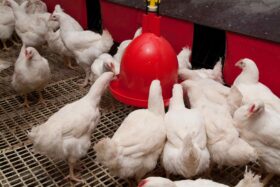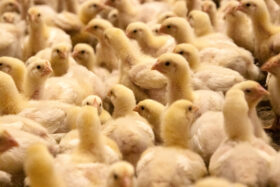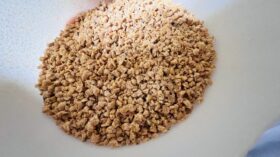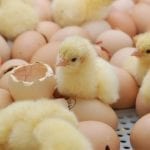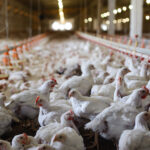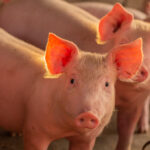Conference Report
At the recent EW Nutrition Poultry Academy in Jakarta Indonesia, Dr Steve Leeson, Professor Emeritus, University of Guelph, Canada, defined metabolic disorders as: non-infectious, occurring with adequate diets in ‘normal’ conditions, and mostly species-specific. Their incidence is negatively correlated to productivity. Although they often have a major genetic component, genetic selection to manage the problem is often a last resort, as there is usually a negative correlation with productivity.
Ascites
First reported in the 1970s, ascites or ‘water belly’ is probably the number one metabolic issue today. It is the accumulation of fluid in the abdomen, which is caused by a cascade of events related to the need to supply high levels of oxygen to the tissues. The condition was initially most prevalent in fast-growing male broilers maintained at high altitude and where there is a degree of cold stress, but nowadays the problem can occur at any altitude. In extreme situations up to 8% mortality is seen, although 1-3% mortality is currently more common. The disorder is now re-emerging with faster growth rates, as growth rate is easily the main contributing factor.
Options to limit ascites include:
- Limit growth rate
- Feed texture (mash vs. pellets)
- Never let the temperature get below 15oC for any age of bird
- Brooding ventilation – economics of air flow vs. temperature
- Minimize environmental contaminants, such as dust
- Lighting programs (4-6 hours of darkness)
Sudden death syndrome (SDS)
SDS almost always affects males birds close to market weight. It frequently afflicts 1-5% of the flock and from 21-35 days it will usually be the major cause of death. Afflicted birds appear healthy, are well fleshed and invariably have feed in their digestive tract. Death occurs within 1-2 minutes, the birds most frequently being found dead on their backs. There are few changes in gross pathology. The heart may contain blood clots, that are likely post-mortem in origin, and the ventricles are usually empty. Diagnosis is usually by exclusion of other diseases. The lungs are often oedematous, although this usually occurs when birds spend time on their backs and fluid drains to the lung region by gravity. There are no specific changes in the tissue or blood profile that can be used for diagnosis. The condition is precipitated by fast growth rate, and so conversely it can be prevented by varying degrees of nutrient restriction.
Spiking mortality syndrome (SMS)
SMS is characterized by severe unexplained hypoglycemia, and always occurs from 18-21 days of age. There are few post-mortem observations, so it is often misdiagnosed. Mortality can be 2-3%. Males are more susceptible than females, probably because they are growing faster. Birds fed all-vegetable diets may be more prone to SMS. Supplementing an all-vegetable diet with milk-powder (which is high in serine), casein or serine is recommended and results in increased blood glucose.
Skeletal integrity
This disorder is not due to increased bodyweight of broilers, as the broiler is capable of supporting weight that far exceeds its own body weight. Instead, it’s due to shifting the bird’s center of gravity forward as breast muscle yields have increased, moving the legs further apart which puts torsional pressure on the head of the femur. Not only does it cause on-farm problems, but also complications with mechanical processing.
Imbalanced nutrient supply, such as excess of chloride, or infection with bacteria, viruses, and particularly mycoplasmas are involved.
Tibial dyschondroplasia (TD)
TD is due to abnormal cartilage development. Failure of normal vascularization limits mineralization. TD is characterized by enlargement of the hock, twisted metatarsi, and slipped tendons. A low electrolyte balance (<200MEq), high chloride (>0.3%), or low Ca:P or high P:Ca can precipitate TD. Adding manganese and choline to the diet will largely eliminate it.
Perosis
Now often termed Chondrodystrophy, it has manganese or choline deficiency as the classical cause, but it can also be seen with other B-vitamin deficiencies. As with TD, it can be aggravated by some grain fumigants.
Kinky back
Also known as Spondylolisthesis, it is not really a metabolic disorder, as Enterococcus infection is the most common cause. Chickens with kinky back syndrome are often seen sitting on their tail, extending their feet outward or letting them fall over to one side of their body. Once the condition stops birds from being able to walk, they are unable to reach food or water on their own and are at risk of dying from starvation. There is no treatment for kinky back.
Gizzard erosion and proventriculus
Although gizzard lesions are very common, Dr Leeson suspects their importance is overemphasized. Gizzard condition is seen in both layer and broiler chickens, but the incidence is more in broilers.
Access to grit and inclusion of at least 20% cereal particles larger than 1 mm in size in the diet will have a positive effect on the development and functioning of the gizzard and it will also reduce the frequency and severity of gizzard lesions in poultry. Ingestion of non-soluble fibers has been shown to exert strong effects on the structure and function of the gizzard. Inclusion of at least 3% coarse fibers in the feed increased the relative weight of the gizzard and reduced the pH of the gizzard contents suggesting a preventive effect of fiber.
Proventriculus appears as a very large organ and is often associated with gizzard erosion. When the proventriculus glands are affected, there is a lower secretion of hydrochloric acid and enzymes and therefore more undigested feed arrives to the intestine, where it can act as a substrate of pathogens and start digestive infections.
Breast muscle defects
Breast muscle defects are not problematic for the bird, efficiency/economics of growth, or a food safety issue. The main issue is seen at primary or secondary processing, and consumer acceptance. Due to the fast muscle growth and the enlarged muscle cells, the space between muscle fibers is reduced. This restricts the blood supply to the muscles, which can no longer reach the desired oxygen levels.
White-striping
White striping is a quality factor in chicken breast meat caused by deposits of fat in the muscle during the bird’s growth and development. It is like marbling in red meat. Dr Leeson joked that it be promoted as marbled chicken – like Wagyu beef. Because hypoxia is associated with white striping, it was thought that arginine supplementation could help with vasodilation, thus supplying the muscles with better oxygen resources.
Wooden breast (WB)
WB is an emerging quality defect. Macroscopically, it is characterized by palpably hard, pale ridge-like bulges at the caudal end, along with clear viscous fluid, small hemorrhages, and white striping, that may occur separately or together. The main cause is the high growth rate and high breast meat yield. There is no nutritional or management solution.
Wooden breast is common in male broilers >2.5 kg bodyweight, and the incidence tends to increase with the size of the breast fillet. As the incidence of wooden breast increases, the incidence of white striping tends to decrease. Due to the visual defects and hard and chewy texture, consumers have a low acceptance of WB fillets, and they are usually downgraded to use for ground products.
Reducing oxidative stress and supplying more oxygen to the cells, enabling the muscle cells to grow very fast without meat loss will reduce the incidence of WB.
***
EW Nutrition’s Poultry Academy took place in Jakarta and Manila in early September 2023. Dr. Steve Leeson, an expert in Poultry Nutrition & Production with nearly 50 years’ experience in the industry, was the distinguished keynote speaker.
Dr. Leeson had his Ph.D. in Poultry Nutrition in 1974 from the University of Nottingham. Over a span of 38 years, he was a Professor in the Department of Animal &Poultry Science at the University of Guelph, Canada. Since 2014, he has been Professor Emeritus at the same University. As an eminent author, he has more than 400 papers in refereed journals and 6 books on various aspects of Poultry Nutrition & Management. He also won the American Feed Manufacturer’s Association Nutrition Research Award (1981), the Canadian Society of Animal Science Fellowship Award (2001), and Novus Lifetime Achievement Award in Poultry Nutrition (2011).







